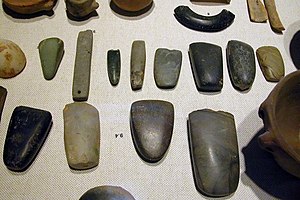 A lot of things went through my mind as I read Denis McGrath's post, Are Hi-tech solutions contingent on Lo-tech solutions? Many of these thoughts were loosely related wonderings (so please be patient ;-p).
A lot of things went through my mind as I read Denis McGrath's post, Are Hi-tech solutions contingent on Lo-tech solutions? Many of these thoughts were loosely related wonderings (so please be patient ;-p).
Denis starts from the "premise that all artifacts we use - are man made, therefore they are in essence human developed technologies". Although he doesn't state that man-made = tangible objects, this got me thinking, especially as later he mentions human speech as a technology. Can something that is (certainly prior to writing) intangible therefore be considered an artifact? If 'no', can it therefore be considered a technology? It is certainly a tool, though.
So, I did a bit of digging around (as you do).
The Free Dictionary defines artifact in four different ways" "An object produced or shaped by human craft", "Something viewed as a product of human conception or agency rather than an inherent element", "A structure or feature not normally present but visible as a result of an external agent or action", and "An inaccurate observation, effect, or result, especially...in scientific investigation or from experimental error".
These definitions (while not all relevant to the context), I feel help illustrate the complex interplay of the notion of technologies as artifacts as objects shaped by human craft, and as intangibles that are a product of human conception or agency.
This wider take on artifacts perhaps helps to provide and insight into what happens when we use technologies, compared with consideration of the technology itself. As such, social networks, online communities of practice etc, can all be considered artifacts.
When the notion of artifacts as both tangible and intangible comes into play, there are further considerations around the concept that:
technical things have political qualities. At issue is the claim that the machines, structures, and systems of modern material culture can be accurately judged not only for their contributions to efficiency and productivity and their positive and negative environmental side effects, but also for the ways in which they can embody specific forms of power and authority (p. 121, Winner, 1986).The examples Winner uses illustrate how intended consequences, are frequently underpinned by unintended aspects related to control, as well as political and social effects. As an example, consider the uptake and adaptation of the original design of MOOCs (that has its roots in Connectivism) by large universities and businesses. It might indeed be extrapolated that
specific features in the design or arrangement of a ... system [are providing] ... a convenient means of establishing patterns of power and authority in a given setting (p. 134, Winner, 1986).While this in itself remains a controversial suggestion, I do feel that it may offer insights into how and why technologies have (or haven't) been adopted by formal education systems and institutions, and in turn why wide scale adoption has been patchy and fraught with issues.
Thoughts?
Reference Winner, L. (1986). Do artifacts have politics. In L. Winter (Ed.), The whale and the reactor: a search for limits in an age of high technology (pp. 19-39). Chicago: University of Chicago Press. Image Neolithic artifacts. CC licenced. Wikipedia. http://commons.wikipedia.org/wiki/File:N%C3%A9olithique_0001.jpg
Related articles
- Connectivism (nakeshajones2.wordpress.com)






No comments:
Post a Comment